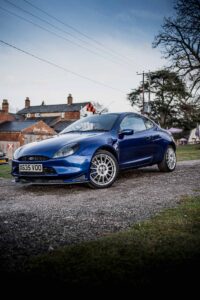The limited-edition Ford Racing Puma represents a kind of car that’s almost completely disappeared from present-day dealerships. What made the little road racer so special?
Looking at the team behind the original Ford Puma is like looking at the lineup of a late ‘90s automotive supergroup. Providing the rhythm, Fiesta-based underpinnings honed by the late Richard Parry-Jones, the chassis wizard whose work at Ford in the 1990s made exceptional driving dynamics accessible to the masses.
On vocals, a range of fizzy, energetic four-cylinder powerplants co-developed by Yamaha, producers of some of the most exquisitely engineered bike engines of all time.
And, providing the ensemble with its all-important stage presence, a curvaceous body by Ian Callum, the man who went on to drag Aston Martin and Jaguar’s design languages kicking and screaming into the 21st century.
The Racing Puma, then, to round off this tortured metaphor, is the remix – an extra-slick layer of production, thanks to of a few choice modifications.
Strictly speaking, the 500 FRPs produced were standard 1.7-litre Pumas with the ‘Racing Puma’ option pack, a sneaky way around the cost and inconvenience of homologating a new car. A hefty £23k outlay bought the base car, plus a one-way ticket for it to long-time Ford tuners Tickford, who set about transforming it into a rabid road racer.
Everything about the Racing Puma’s body was pumped up – the suspension was lowered, the wheels jumped from 15 to 17 inches and the track was widened, with Callum’s bodywork updated with startlingly blistered arches to accommodate the changes.
The punch to match the streetfighter looks came courtesy of Tickford’s expertise in old-fashioned, nuts-and-bolts upgrades, with an uprated manifold, exhaust, cat, and cams taking power to 153bhp – not insignificant in a car coming in not far over a tonne.
Sold exclusively in the UK and finished in lustrous Imperial Blue, the Racing Puma has come to be regarded as an era-defining FWD car. It’s music to our ears.

















